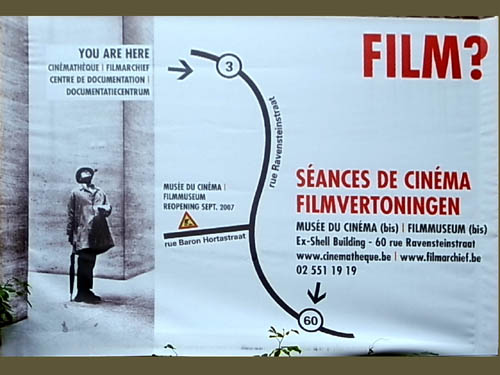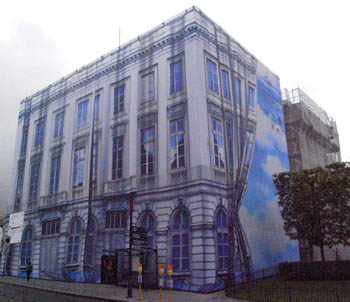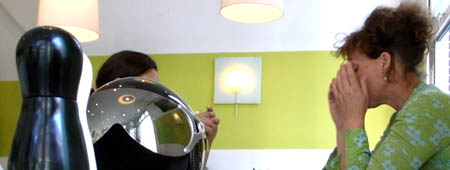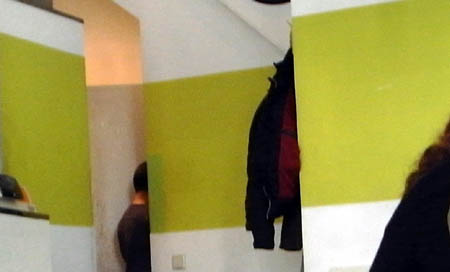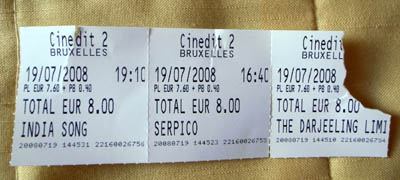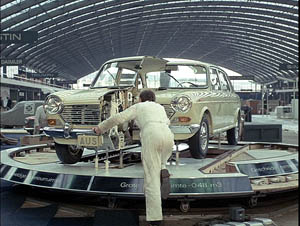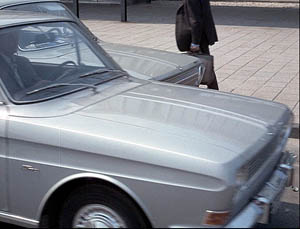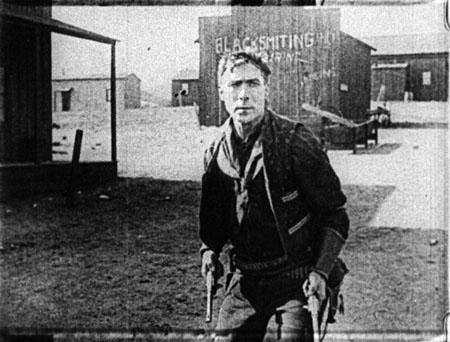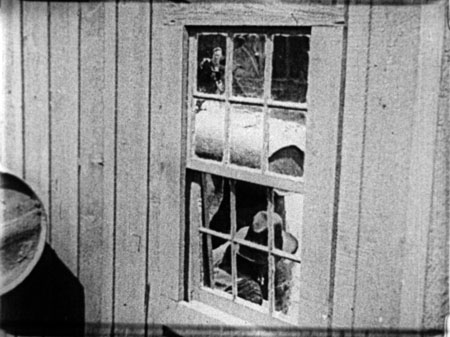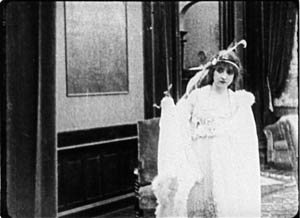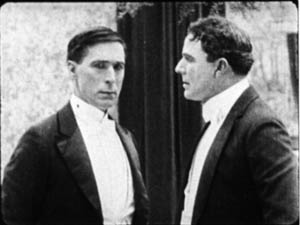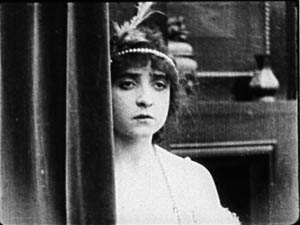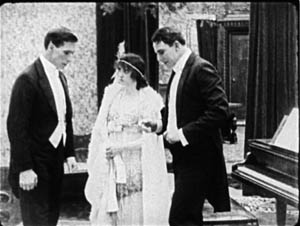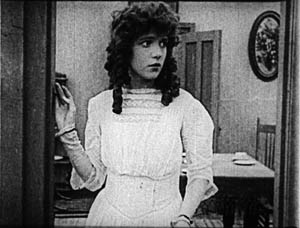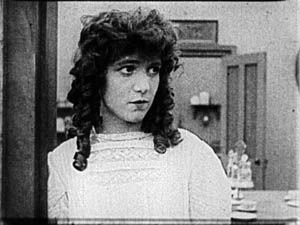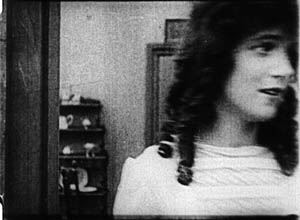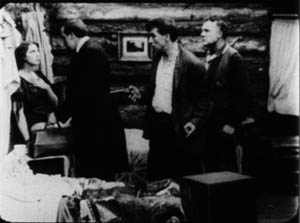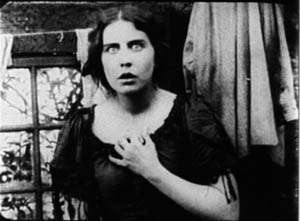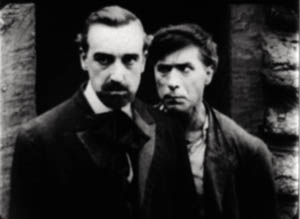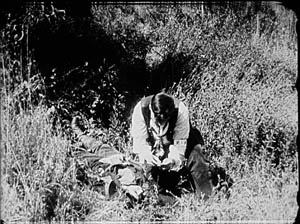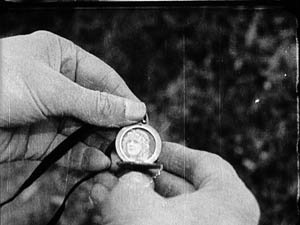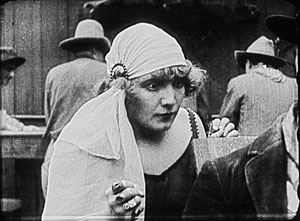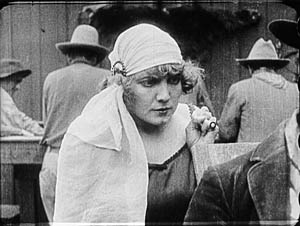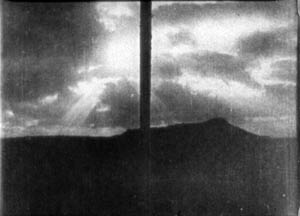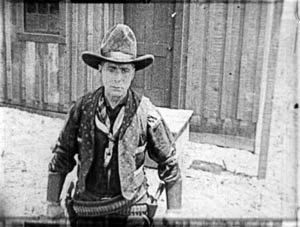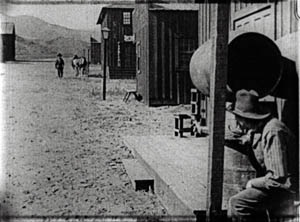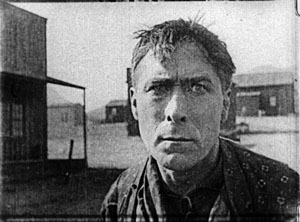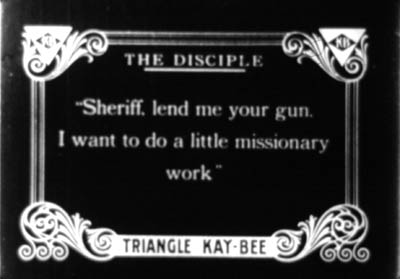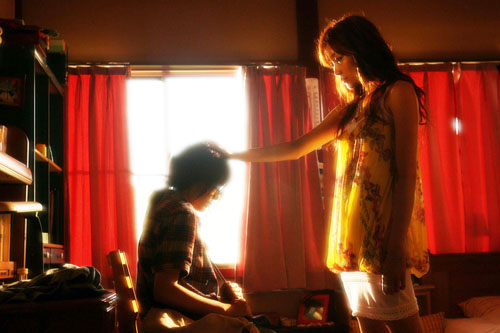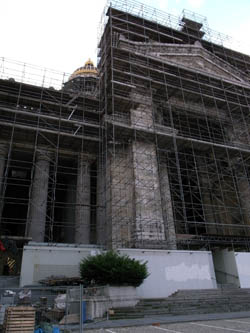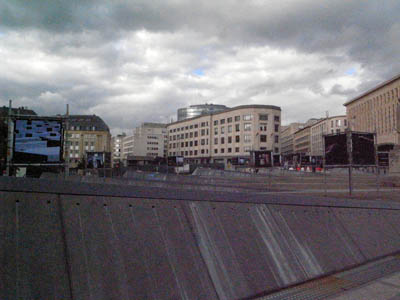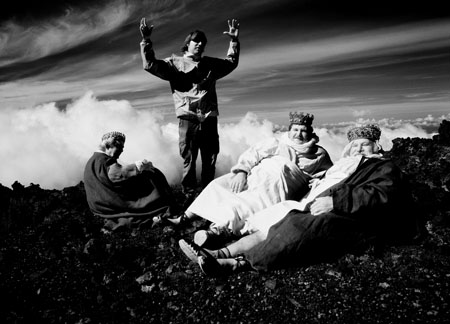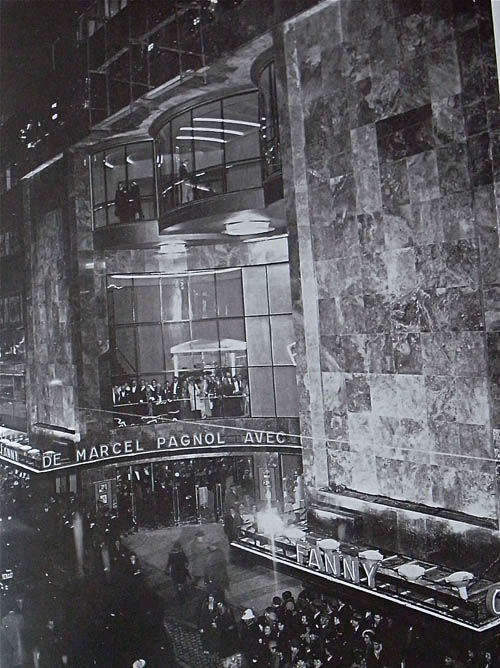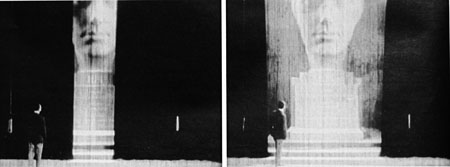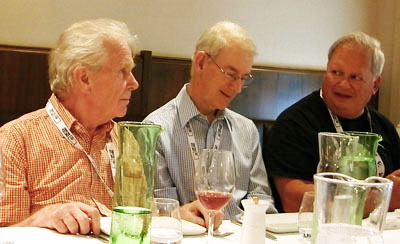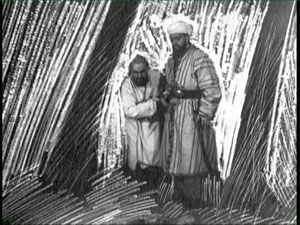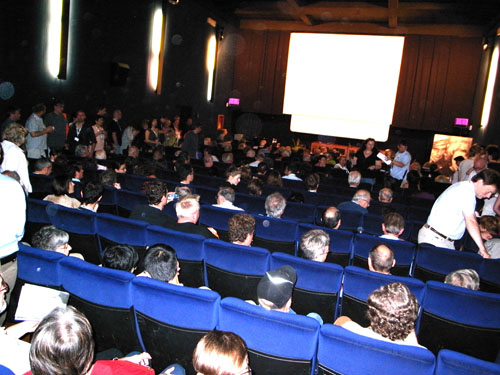Archive for 2008
Summer show and tell
DB here:
I came back from a month in Europe to find a stack of magazines, books, and DVDs waiting. There was Before the Rain, much Cecil B. DeMille, and a mass of Anthony Manns (some discussed on Jonathan Rosenbaum’s blog). How will I ever catch up? I was reconciled to the idea that I’d die before reading every book I owned, but now I have to face the same conclusion about movies on discs.
Herewith some items from my trip to Amsterdam, Bologna, and Brussels that I couldn’t squeeze into earlier blogs. I end with the movie I watched upon my return.
DaViD’s DVD depredations
In Bologna, I learned that Oksana Bulgakowa is at work studying how cinema captured everyday human gestures at earlier points in history. Visit her site, where a DVD is available on her research.
Speaking of DVDs, travel inevitably brings them into your baggage, despite the high prices and the abysmal exchange rate.
*At Bologna our Copenhagen pals gave us the new Danish Film Institute DVD, Danish Experimental Classics 1942-1958. Not quite yet available for sale, it should show up here—as has a third collection of Jørgen Leth movies. While you’re sniffing around the site, eyeball the archive’s new state-of-the-art storage facility.
*Hubert Niogret, indefatigable director of documentaries on Asian cinema, has also produced an excellent collection of interviews, Mémoires du cinéma francais: De la libération à nos jours. Together we sampled an outstanding Bologna specialty, gramigna con salsiccia.
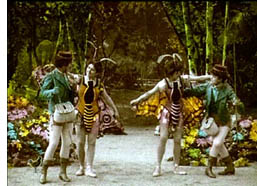 *Isabel Biver passed along the latest installment of Imagination in Context, a series of books and discs about early cinema and Antwerp. Animalomania includes English-language text and some nice films, including a hand-colored fantasy about butterfly collectors who wind up with pretty girls dressed as butterflies.
*Isabel Biver passed along the latest installment of Imagination in Context, a series of books and discs about early cinema and Antwerp. Animalomania includes English-language text and some nice films, including a hand-colored fantasy about butterfly collectors who wind up with pretty girls dressed as butterflies.
*At a sale table I found the Index DVD of Ivan Ladislav Galeta’s works, which includes the remarkable Two Times in One Space (1976/1984). I caught up, finally, with the Austrian Film Museum’s reconstruction of Frank Borzage’s The River.
*In Brussels I picked up the StudioCanal collection of Méliès films, which complements the recent Flicker Alley collection. Of course then I had to splurge on Laurent Mannoni’s gorgeous book, L’oeuvre de Georges Méliès.
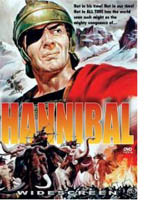 *Also snagged a batch of Gosha and Uchida swordplay movies, but in the Japanese line my real finds were a French edition of Night and Fog in Japan, one of Oshima’s finest (also just out in the UK) and the Carlotta set of three 1930s Mizoguchi films: The Downfall of Osen, Oyuki the Virgin, and Poppies. All drawn from 16mm copies, these items vary drastically in quality. Osen is superb, but Oyuki is iffy, and Poppies is a rain of scratches, the worst copy I’ve ever seen.
*Also snagged a batch of Gosha and Uchida swordplay movies, but in the Japanese line my real finds were a French edition of Night and Fog in Japan, one of Oshima’s finest (also just out in the UK) and the Carlotta set of three 1930s Mizoguchi films: The Downfall of Osen, Oyuki the Virgin, and Poppies. All drawn from 16mm copies, these items vary drastically in quality. Osen is superb, but Oyuki is iffy, and Poppies is a rain of scratches, the worst copy I’ve ever seen.
*To top things off, Tom Paulus of the University of Antwerp, bestowed upon me his extra copy of Edgar G. Ulmer’s Hannibal (1960) in SuperCineScope. This is what friends are for.
Interlude: Some Europix, arty and otherwise
My last sigh x 3
Every summer the Arenberg cinema holds a retrospective season, Ecran total, and it helps make Brussels a great film city. This time there were cycles dedicated to Delphine Seyrig, Al Pacino, the Japanese New Wave, and children, as well as a batch of classics. Prints are usually fresh, and the programming is very eclectic. So Saturday, the day before I flew home, I saw three movies at the Arenberg. I liked the West Anderson better than I expected to, though the clash between the overall feyness and a child’s death left me a little stranded emotionally. I had forgotten the Lumet since the initial release; not up to Prince of the City methinks, but a sturdy, earnest piece of work. The Duras proved as mesmeric as ever, and still unthinkable on DVD (even though I have two DVDs of it). All in excellent prints and pinpoint-sharp projection. Cinephilia satisfied: No need to watch anything on the plane home the next day.
No need to eat much either, because of a delicious late meal with our old friend Geneviève van Cauwenberge, head of the film and media program at the University of Liège.
Trafficking
 For my avant-birthday, Kristin (a) bought me a beautiful Krazy Kat page; (b) took me out for sushi; and (c) settled in with me to watch the new Criterion disc of Jacques Tati’s Trafic. It’s been one of our favorites for a long time; I saw it on initial release in Paris while researching my dissertation. It’s not as densely loaded as Play Time, nor as structurally rigorous as M. Hulot’s Holiday. (Kristin wrote about both these films in her book Breaking the Glass Armor; my bias aside, her analyses are really illuminating.) Trafic has its own charms, though, and Gary Giddins gets at several of them here. We’ve collected versions on tape and even a Finnish DVD, which calls him Tatin, but the Criterion looks to be the best version yet. (Still, why not anamorphic?)
For my avant-birthday, Kristin (a) bought me a beautiful Krazy Kat page; (b) took me out for sushi; and (c) settled in with me to watch the new Criterion disc of Jacques Tati’s Trafic. It’s been one of our favorites for a long time; I saw it on initial release in Paris while researching my dissertation. It’s not as densely loaded as Play Time, nor as structurally rigorous as M. Hulot’s Holiday. (Kristin wrote about both these films in her book Breaking the Glass Armor; my bias aside, her analyses are really illuminating.) Trafic has its own charms, though, and Gary Giddins gets at several of them here. We’ve collected versions on tape and even a Finnish DVD, which calls him Tatin, but the Criterion looks to be the best version yet. (Still, why not anamorphic?)
Trafic is definitely odd, with a choppy opening and quickly-cut extreme long shots. This time around I was struck by how much a landscape artist Tati was. Sometimes he built his own massive milieu, as in Play Time, and sometimes he merged his constructed spaces with the real world, as in the houses of Mon Oncle. In Hulot and Trafic he exploited the vastness of real spaces, usually the backdrop for human foibles made minuscule. Trafic gives us a un-picturesque European countryside. Sliced by superhighways, the bland vistas are dotted with rusted cars, empty fields, and forlorn gas stations. Drivers hiking off for fuel or trying to patch up their vehicles dwindle to pathetic dots in the image. Cities are no better, choked with pale cars that advance fitfully. Then there’s the huge convention center housing the auto show. The opening gag of men stepping carefully over stretched strings that we can’t see etches tiny gestures into a monumental frame. Masters of ambivalent vastness: Antonioni, Angelopoulos, Tarr….and Tati?
The setpiece of Trafic is of course the car crash, and it, like Tati’s characteristic running gags (e.g., cheap busts of historical figures as bonuses for gas fillups), reminds us of the follies of the car culture. In a sense, the entirety of Trafic seems an outgrowth of Play Time‘s final sequence, which turns a traffic roundabout into a carousel. But here there’s little sense of a mundane world transformed into a playground. Instead, modern misery remains the norm, as pedestrians zigzag their way through infinite gridlock.
Beyond the satire, which can get fairly caustic, I have always loved Tati for juxtapositions so weird and remote that you wonder if they could count as gags. Then you wonder if you’re the only person to notice them. In Play Time, everybody gets the running gag about the drunk at the bar of the Royal Garden tipping over on his stool. Far less evident is a moment I always find disconcerting. When the air-conditioning at the restaurant is finally switched on, the air vents make the loose skin on one woman’s back ripple. The denunciation of flabby bourgeois comfort comes and goes in a flash, and when I first noticed it in the 1970s I thought: Is it accidental? Did Tati mean for me to see it? Does anybody else notice? And does this count as a gag, or just, well, peculiar?
Likewise, in Trafic, Tati can cut from a bisected car on display to a quasi-abstract angle on traffic, with one fender sliding past an identical one.
We’re supposed to notice the purely sculptural analogy of split cars. And we’re supposed to find it at least a little funny. Right? Right?
Whether you agree or not, Tati’s vacant long-shots and unpredictable cutting leave space for such musings. Comedy with a question mark, from one of the dozen or so greatest directors who ever lived.
Kristin is now at Comic-Con, armed with fan-friendly T-shirts and a carrier bag from Lambiek. Her mission: to sell a copy of The Frodo Franchise to each of 125,000 attenders. Expect dispatches from her in the days to come.
P. S. My thanks to the staff of the vaults at the Royal Film Archive of Belgium, who were extremely helpful during my visit. I didn’t manage to photograph everybody, but I owe special gratitude to the supervisor Marianne Winderickx, pictured below.
PPS 24 July: Olli Sulopuisto clears up my Tatin puzzlement: “In Finnish the trailing n is the mark of a possessive, similar to ‘Jacques Tati’s…'” Thanks to Olli.
Rio Jim, in discrete fragments
The first moving-pictures, as I remember them thirty years ago, presented more or less continuous scenes. They were played like ordinary plays, and so one could follow them lazily and at ease. But the modern movie is no such organic whole; it is simply a maddening chaos of discrete fragments. The average scene, if the two shows I attempted were typical, cannot run for more than six or seven seconds. Many are far shorter, and very few are appreciably longer. The result is confusion horribly confounded. How can one work up any rational interest in a fable that changes its locale and its characters ten times a minute?
H. L. Mencken, 1927
DB here:
Between about 1913 and 1920, the way movies looked changed, and we are still living with the results. What were the changes? What brought them about?
I’m just back from Brussels, after a two-week visit to the archive. During earlier trips, I’ve concentrated on examining films from the 1910s that exemplify the tableau tradition. That’s what we might call the stylistic approach that tells the story and achieves its other effects predominantly through staging—by arranging the actors within the frame, forming patterns that reflect what is important at a given moment.
The tableau tradition dominated European cinema of the early and mid-1910s, and it was also on display in the U. S. It is sometimes considered “theatrical” and “uncinematic,” but that’s a shortsighted view. The tableau tradition is one of the great artistic triumphs of film history. For backup on this, consult Ben Brewster and Lea Jacobs’ Theatre to Cinema and my On the History of Film Style and Figures Traced in Light. And you can go here and here on this site.
As the 1910s moved on, the staging-driven approach gave way to one dominated by editing. Roughly speaking, this strategy surfaced at two levels. Directors began to use crosscutting, aka parallel editing, more strenuously. By alternating shots, you could show events taking place at two or more locations. This technique was not used only for last-minute rescues; it was a way of keeping track of all the characters in nearly every sequence, whether they were going to converge or not.
Second, within a single strand of action, 1910s directors exploited analytical editing, breaking down a scene’s space into a host of details. Griffith often gets the credit for this tactic (and he happily claimed to have invented it), but it’s probably most fairly understood as a collective innovation.
Directors in the tableau tradition didn’t entirely avoid crosscutting or analytical editing, but there was a measurable shift of gravity in the second half of the 1910s. In the U.S., many filmmakers pushed editing techniques very hard. You can sense their exhilaration in discovering how editing lets them control pacing, make story points concisely, build suspense, and force the viewer to keep up.
During the 1910s, American movies became breathless. The hurtling pace of Speed Racer or The Dark Knight has its origins here; seen today, The Battle at Elderbush Gulch (1913) and Wild and Woolly (1917) still look mighty rapid-fire. And then as now some observers, like Mencken, complained that it was all too fast and furious.
Over the last thirty years, many scholars have studied this change, but for a glimpse of some supporting data, you can visit the remarkable website Cinemetrics. Yuri Tsivian, Barry Salt, and a corps of volunteer scholars have been measuring Average Shot Lengths in films from all eras. The data from the 1910s are pretty unequivocal. In the US around 1916-1918, movies became editing-dominated, shifting from an ASL of over 10 seconds, sometimes as much as 30 seconds, to 5-6 seconds or less. A 4-6 second average per shot persists in Hollywood through the 1920s, so Mencken’s guess about the “scenes” (as shots were then known) changing ten times a minute was more or less right.
Back in the 1980s, Salt and others, including Kristin and me, picked 1917 as a plausible point of reference for the consolidation of the continuity style. That was the point at which virtually every US film we watched contained at least one example of specific continuity techniques. (Most contained many more instances, of course.) We talk about that magical year in this entry, which you might want to read as an introduction to what follows today.
In just a few years, continuity editing became a coherent, supple means of expression, and it has defined Hollywood film style up to the present. What brought this about? Kristin and Janet Staiger offered an explanation in our 1985 book, The Classical Hollywood Cinema: Film Style and Mode of Production to 1960. They traced out several factors that encouraged and sustained this style. Especially important were the development of longer films, a conception of filmic quality, and the emergence of a specific division of labor.
Lately I’ve been revisiting these early years, chiefly to watch how directors pick up and refine the stylistic schemas that were coming into broader use. I want to know more about the little touches that directors had to control in creating this style. I’ve also been interested in to what extent these techniques were picked up by directors in Europe and Asia. The evidence is pretty clear that continuity cinema became a lingua franca of film style.
So if last year I pondered the minute compositional adjustments of Evgenii Bauer, this year it was all cutting. I focused on three filmmakers, but I’ll save discussion of two of them for a rainy day, or a book. In all, it was a thrill, as ever, to watch a stylistic system coalesce across a batch of films that are seldom mentioned in the history books.
The trail to continuity
The extraordinary films starring William S. Hart typify early American continuity techniques. After a distinguished career on the stage, Hart began as a film actor in 1914, when he was nearly fifty. He was intent on bringing realism to the newly burgeoning Western genre. His films were at first made under the auspices of Thomas Ince, a pioneer of rationalized production techniques, and with his Ince pictures Hart found worldwide success. He followed a rousing feature debut (On the Night Stage, 1915) with many shorter films. In 1917—mark the year—Hart broke with Ince and set up his own firm for The Narrow Trail. He continued to make films into the early 1920s, with Tumbleweeds (1925) marking his farewell to cinema.
Hart often directed his own pictures, though he also had the services of strong directors like Reginald Barker. The films have an assured brio, thanks to careful cutting and some felicitous touches.
They are fast-moving: In the five 1915 Hart films I watched, the ASL ranged from 8 to 11 seconds, but in 1916, the average jumped to 5-6 seconds per shot. The Narrow Trail seems to have an ASL of 3.7 seconds, but I can hardly believe it and I must verify it with another viewing. The 1918 and 1920 films I viewed average between 4.9 and 5.4 seconds per shot.
Just as important as the speed of cutting, naturally, is what Hart does with his cuts. In one scene from Between Men (1916), you can see the tableau aesthetic undermined by analytical editing. Gregg is a shifty stock trader, a species we still nurture. He’s trying to destroy Hampton’s fortune because he thinks that when the old man is destitute he’ll force his daughter to marry Gregg. Hampton has asked Bob White (Hart) to help get the goods on the suitor.
In one scene, the master shot approximates a tableau setup: Bob and Gregg stand in the middle ground, with a room visible behind them.
As the men swap increasingly tense challenges, Margaret Hampton enters the adjacent room and stands behind them as they talk. A director in the tableau tradition would have sustained the master shot and shown Margaret approaching in the background and drawing closer, reacting to what the men say. She could easily have been stationed hovering at the curtain on the right.
Instead, director C. Gardiner Sullivan has her arrive from another doorway in the adjacent room, one not visible in the master shot of the two men. He then cuts back and forth between the men and Margaret, and he positions her at the left curtain–so that the men block her from our view! The blockage motivates cutting to Margaret for her reactions to what Bob and Gregg say.
Only when she wants to challenge Bob’s suggestion that he might marry her does Margaret come into the same frame as the men, who part to make room for her.
It turns out that this sequence is but a rehearsal for a lengthier passage in which Hampton will come in from the adjacent room (via the door we do see in the background). As with Margaret’s entrance, his arrival will be blocked by Gregg’s body, and Sullivan will cut among the trio in the foreground and Hampton’s approach behind them. That passage, which could also have been handled in a single framing in the tableau style, consists of four distinct setups and eighteen shots!
So even depth-based scenes can be recast as rapid découpage. The passage is probably overcut, but you can sense the filmmakers’ exhilaration in their power to chop up the world into separate, slightly jolting bits, forcing the audience to keep abreast of each item of information.
Managing details
The variety of setups is worth noticing in another film, for here we can see the filmmakers taking pains to show each bit of action most clearly and emphatically. In The Return of Draw Egan (1916), when Egan sees the mayor’s daughter Myrtle he decides to stay on as marshal of Yellow Dog. The first shots show them looking at each other.
The next pair of shots shows the two looking at each other in close-up.
This gradual enlargement of the figures in a reverse-shot sequence would of course become a staple of analytical editing—perhaps it already was in 1916. Cut back to another framing of Egan, as the mayor signals Myrtle to join them. The slightly off-center composition reiterates her position off left.
Cut back to Myrtle, exiting her close-up. The next shot shows her joining the men, to be introduced to Egan.
But this is a different camera position than the one showing the men just previously. The daughter’s entrance has motivated a slightly changed composition. In the 1910s, cutting began to dictate staging, so that each composition had to fit smoothly into the flow of shots.
This sequence from Draw Egan doesn’t utilize axial cuts, those cuts that keep to the same angle and move straight in or out. Here the actors are angled to suggest that we are to some degree in between them. Indeed, sometimes the camera will put us directly between the characters. Here is a climactic confrontation from The Disciple (1915). A doctor has cuckolded Hart, but Hart brings him to save his daughter. As the doctor enters, the wife’s shameful look is met by Doc’s anxious expression, with a furious Hart pressing a pistol to his back.
This freedom of camera placement extends to point-of-view cutting. Again, this is an old technique, but like other old techniques, it was revived and refined as part of the synthesis that became the continuity style. So Keno Bates, Liar (1915; a splendid title) can make use of a cameo picture that captivates Bates after a shootout with the man who robbed him.
Later, the dance-hall girl catches sight of her rival when Bates muses on the cameo.
The pov framings don’t change much, but the angle chosen easily approximates both Bates’ view and her view over his shoulder. Moreover, the shot of Bates’ hands isn’t the sort of vacuous insert we often see at the period, with a letter or an object isolated against a blank ground. Here, the backgrounds change, so that the first shot is situated naturally in the wild, while the second is consistent with the barroom locale.
Putting the pieces together
From very early in the history of Westerns, the main street shootout seems to have been a solid convention. Already in The Return of Draw Egan, it’s treated with a vitality and ingenuity that suggests creative reworking of a staple. The climactic shootout also shows just how flexible the new technique could be.
Egan has told his enemy, Arizona Joe, that he’ll meet him when the setting sun’s rays hit the saloon window. So the film crosscuts Egan in his marshal’s office with a nervous Joe, seen in close-up, eyeing the window.
When Joe gets up the nerve to leave, he hides behind a barrel and waits to ambush Egan. When Egan leaves his office, a reverse tracking shot follows him striding toward us.
Then we get an orienting long shot with Joe in the foreground and Egan approaching.
Edging sideways, Egan spots a reflection of Joe’s head in a window. These shots surmount today’s blog entry. You can see Egan’s reflection in the upper left pane.
Now aware of Joe’s tactic, Egan steps diagonally forward, coming ominously right up to the camera.
He fires and dispatches Joe. The townsfolk, who have been huddled in a house watching, declare they want Egan to stay on as marshal, despite his outlaw past. Myrtle chimes in, and we get a happy ending. Chaotic fragments? Mencken couldn’t have been more wrong. Or maybe he was just being grumpy.
The trail to Hollywood
There’s plenty more in these films—beautiful, sometimes minuscule matches on action; subtle timing of frame entrances and exits; and even proto-over-the-shoulder reverse shots. And we don’t have to claim that Hart’s films are the only innovative ones. They take their place within a broader, collective achievement that we still haven’t fully grasped.
Editing permitted everyone to act at small scale; the bargirl who sees Bates’ cameo need only lower one fist, tighten the other, and narrow her eyes to express her jealousy. The new style nurtured laconic stars like Hart. His films are full of pathetic situations that demand he display stoicism but also sensitivity. The long shots could emphasize his gestures and stances, while close-ups could display his worn, haunted face and pale eyes. He acts with those eyes, glancing aside to recall a traumatic event or looking downward as he hesitates to break bad news. Often the plot demands that he conceal his feelings or hide the truth behind an event, and the changing shots could penetrate the surface drama and highlight his slightest reactions. Hart could underplay his role because the editing shows us everything he might have said.
Known in France as Rio Jim, Hart was very influential on the Europeans. His pictures, along with De Mille’s The Cheat (1915) and the films of Chaplin and Fairbanks and many others, offered tutorials in the new style. Arguably, the cumulative force of these mainstream releases was greater than the influence of Griffith’s more prestigious output of the moment. There was only one Intolerance (1916), the film by which Griffith was most widely known abroad, but week by week the Westerns and comedies and dramas pouring out of Hollywood flaunted a new, almost frighteningly energetic approach to cinema.
Timing favored the Americans. The style emerged at around the start of World War I, when hostilities gave U. S. films a chance to displace the big French and Danish companies in many markets. Kristin explains how this happened in Exporting Entertainment, and she talks about the exceptional case of Germany in Herr Lubitsch Goes to Hollywood.
Some European directors picked up the new style immediately, others took a bit longer, and a few, like Feuillade, never fully adjusted to it. The principles of the older tableau style never utterly died out, as I try to show in Figures Traced in Light. But the future belonged to the editing-based aesthetic. Canonized, tweaked, updated, dismantled, undermined—however filmmakers reacted to classical continuity, it became the basis of international cinematic storytelling.
My epigraph comes from H. L. Mencken, “Appendix from Moronia: Note on Technic,” from Prejudices: Sixth Series (New York: Alfred A. Knopf, 1927), rep. in Phillip Lopate, ed., American Movie Critics: An Anthology From the Silents Until Now, expanded edition (New York: The Library of America, 2006), 35-36.
Silent film speeds can vary, so shot counts can yield different averages. I saw some of the Harts I mention in projection at last year’s Il Cinema Ritrovato, and they were projected at 18 or 19 frames per second, a common speed for the period. My ASLs are based on the running time. For the titles I saw in Brussels on a flatbed viewer, my basis was the length in meters. From that I’ve calculated running times and averages, assuming 18 frames per second. Projectionists of the time had freedom to screen at different speeds, so it’s possible that late 1910s Hart films were sometimes shown at 20 frames per second, which of course would make their cutting pace even faster.
For more on Hart’s career, see Diane Kaiser Koszarski, The Complete Films of William S. Hart: A Pictorial Record (New York: Dover, 1980). Koszarski devotes space to each film, with credits, excerpts from contemporary reviews, and excellent production stills. She also provides a sensitive critical overview. In William S. Hart: Projecting the American West (Norman: University of Oklahoma Press, 2003) Ronald L. Davis has given us a brief, engrossing biography based on interviews and extensive archival research. Hart’s memoir, My Life East and West (1929, reprint 1994) is of course indispensable.
C is for Cine-discoveries
Funuke, Show Some Love, You Losers!
DB here:
Kristin and I think of Brussels as a gray city—gray skies, gray pavements, gray buildings, even gray, if often fashionable, clothes. It isn’t usually a fair description, though. In the twenty-plus summers we have been visiting, many days have been bright. I suppose our impression comes chiefly from one rainy fall we spent here in 1984, on a Fulbright research grant. Still, the public monuments bear us out, especially the Palais de Justice: except for its gold dome, it is gray, and has been encased in gray scaffolding for as long as we can remember.
Indeed, Brusselians assure us that the scaffolding will never go away because it’s holding the Palais up.
The gray motif continues this summer; during my visit, there have been almost no sunny days, just rain and chill. To prove that Belgians have stayed loyal to their favorite color, I took a shot of a new piece of public architecture near the Central Station: a half-circle of tipped-over pyramids that are, ineluctably, gray.
Still, the movies provide my light and color. I talked about Brussels as one of the great film cities in last year’s entry. I found further proof in a 2003 Marc Crunelle’s Histoire des cinemas bruxellois (in a series announced here), a small book with some fine pictures, one of which you will find at the end of this entry.
As usual, my host was the Royal Film Archive of Belgium. The archive offices remain in their splendid old building, the Hotel Ravenstein, but the new museum complex is still under construction. So the screenings continue to be held in the ex-Shell building, a piece of postwar Europopuluxe that I seem to enjoy more than most of the locals.
During my days, I watch films (very, very slowly) in the archive vaults; more about that project in my next entry. At night the event was Cinédécouvertes, the annual festival of new films that don’t yet have Belgian distribution. That festival, going back decades, has now been attached to a bigger event, the Brussels European Film Festival, which this year began on 28 June. BEFF showed thirty new titles, plus eight older items in open-air screenings, and it gave several prizes.
Kristin and I were in Bologna for Il Cinema Ritrovato and so I missed all of these, including the big Flemish film of 2007, Ben X. But Cinédécouvertes, running on during the BEFF, had its second and final week while I was in town. Films screened were competing for a 10,000-euro prize to be awarded to a distributor that would pick up the film. In addition, the venerable L’Age d’or prize would be awarded to a film that maintained the spirit of Buñuel’s scandalous masterpiece.
Herewith some notes on what I saw, and the prize results. Of course on the day I posted this, the sun came out.
Women, prep school, and manga
Cargo 200.
The two Iranian films in the program were earnest but varying in quality. Unfinished Stories (Pourya Azabayjani) is a network narrative following three women across a single night. A suicidal teenager doesn’t return home; her path crosses with that of a wife cast out by her husband; and she in turn brushes past a young woman who tries to smuggle her newborn baby out of the hospital. The situations are engagingly melodramatic, but the links among them (a footloose soldier, a compassionate taxi driver, an enigmatic old man) seemed to me forced, and as is often the case in these tales, the problem is how to conclude each story line in a satisfying way. The use of sound was very fresh, however. I especially liked the teenager’s obsessive replaying of taped conversations with her boyfriend. Often these “auditory flashbacks” are played over a black screen, and they come to exist as discrete, almost virtual scenes.
I like it when a film begins with a sharp, defining gesture, and Three Women (Manijeh Hekmat) had one. In close-up a car drives up to a tollbooth and the driver’s hand tosses a cellphone into a Charity Box there. Someone is on the run and cutting ties, but we won’t find out more for some time.
The first stretch of the movie concentrates on Minoo, a divorced professor and expert in Persian textiles. A rug dealer has promised to keep a precious carpet in the care of her museum, but he changes his mind and tries to sell it. In a fit of temper she grabs the carpet from its owner and takes it to her car, where her somewhat senile mother waits patiently for a trip to the hospital. Then the old lady vanishes. The emphasis shifts to Minoo’s daughter Pegah, who has set out on her own. The maddening Tehran traffic of the early scenes gives way to the empty quiet of the countryside. In the second half of the film, a favorite theme of Iranian cinema—the urban intellectual confronting rural life—is played out vividly when village elders debate whether to stone a woman who has had an abortion.
Like many of the best Iranian films, Three Women tells its story with dramatic force, offering robust conflicts and a degree of suspense rare in arthouse fare. Manijeh Hekmat, who made her name with Women’s Prison, manages the story threads skilfully, creating a continuous revelation of backstory and hints about how the tale will develop. I especially liked the way Minoo gradually realizes that she has had no idea how her daughter is living. As Alissa Simon points out in her perceptive review, Hekmat can spare time for a subtle composition as well. The ending came as a quiet surprise, deflating some dramatic issues but emphasizing the comparative unimportance of carpets, cellphones, and pop music in the face of the deeper problems facing Iranian women.
Add another woman and you have Adoor Gopalakrishnan’s Four Women. The quartet of stories, all adapted from literature and evidently set in the 1940s and 1950s, shows the fates befalling women in different roles, each identified with a title: The Prostitute, the Virgin, the Housewife, and the Spinster. Not much fun to serve in any of them, it turns out. The film has a sharp eye for details of local life and ceremonies, an ambition helped by the high-definition format: a slow-moving river is off-puttingly scummy. A little didactic and schematic, but it’s enlivened by a long sequence of a husband who methodically and endlessly eats everything put in front of him, with a seriousness he cannot bring to his marriage. The sequence starts in bemusement, moves to humor, and persists to the threshold of nausea.
The Argentine La sangre brota (Pablo Fendrik) was a little reminiscent of City of God in its relentless handheld assault on your senses, with the camera grazing faces and people racing in pursuit of drugs and money, with a beleagured taxi driver trying to do the right thing. La maison jaune (Amor Hakkar), from Algeria, appealed more to me. How much we owe neorealism! Quietly and simply, Hakkar tells of a father learning of his son’s death, fetching the body home for burial, and then trying to find a way to relieve his wife’s grief. So he paints his house yellow. Quiet and moving and not as simple, in story or pictorial technique, as it might sound.
Antonio Campos’ Afterschool (US) is a very assured first feature about drug-overdose deaths in a prep school. The story is told almost completely through the consciousness of Rob, an introspective and awkward freshman who indulges in internet porn. Passive to the point of inertia, Rob remains largely a mystery. This effect is often due to Campos’ bold use of the 2.40 widescreen frame, which often excludes some of the most important dramatic information. People are split by the left or right edge, or are decapitated by the top frameline, so we must strain to listen to the conversation and catch glimpses of the characters. This may sound arbitrary, but Campos finds ways to motivate the lopped-off compositions. One shot, when the parents of dead students record their thoughts on video, is one of the strongest pieces of staging I’ve seen this year. Unlikely to get U. S. theatrical release, if only because of its pacing, Afterschool marks Campos as definitely a director to watch. It won one of the two top Cinédécouvertes prizes.
The other top prizewinner was Yoshida Daihachi’s Funuke, Show Some Love, You Losers! It’s another insane Japanese family movie—that is, the family is insane, and the movie acts the same way, out of sympathy or contagion. After the parents are killed trying to save a cat from an oncoming truck (nice overhead shot of bloody skid marks), a new household takes shape. There’s the phlegmatic brother Shinji, his maniacally cheerful wife, his adolescent sister Kyomi, and his sister Sumika, who comes to stay after failing to make it in Tokyo as an actress. Family secrets emerge. Sumika starts turning tricks and Kyomi draws violent manga inspired by Sumika’s adventures. The comedy turns blacker when Kyomi’s comic books become best-sellers and all the family problems regale the reading public. With some scenes shot in high-contrast video, as if they were TV episodes, and a climax that blends film and manga, panel by panel, the film’s style is as all over the map as the characters and their complexes. Good dirty fun from the title onward.
The L’Age d’or prize went, deservedly, to Cargo 200 from Russia. Another black comedy, but one that gets blacker and less funny as it goes along, it becomes sort of a post-Glasnost’ Last House on the Left. (Seriously, maybe there’s an influence of Saw and Hostel here, with hints of Faulkner’s Sanctuary.) Set in 1984 and stuffed with retro clothes, hairstyles, and music, the plot spins crazy-eights around the corpse of a returning Afghan war hero; a teenager trying to buy homebrew vodka; a bootlegger who keeps a Vietnamese refugee as an assistant; a small-town policeman with a penchant for voyeuristic sex; and a professor of dialectical materialism who wanders, blinking, in and out of the lurid plot twists. Director Alexei Balabanov, who did the pioneering rough genre picture Brother (1997), gives no quarter here.
Strength in simplicity
Albert Serra directs the three kings in El cant dels ocells.
My three favorites were all resolutely unfancy. Shultes, a Russian item by Bakur Bakuradze, is a minimalist study of a pickpocket. Shultes lives with his mother, gives some of his loot to his legit brother, and takes up with a boy whom he tutors in thievery. At slightly over 200 shots, the movie is staged, shot, and cut with a precision that reminded me of Apichatpong Weerasethakul (Syndromes and a Century). On the inexpressiveness scale, Shultes, with eyes and mouth too small to fill up much of his face, makes Bresson’s pickpocket look positively other-directed.
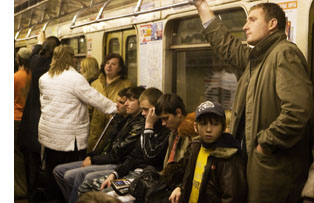 As with all movies about stealing, the pleasure lies in trying to figure out the plan and spot the telltale moves—sort of like the misdirection of a magic act. Here the drama is cunningly contrived. What is Shultes writing in his little brown book? Who is Vasya? What’s his big plan? The plot jumps a level when we realize that all we’ve seen is a flashback, and the ensuing conversation puts things in a startling perspective. Our blankly amoral protagonist even becomes a shade sympathetic. Too rigorous and unemphatic to be an arthouse import, I fear, but ideal for a festival.
As with all movies about stealing, the pleasure lies in trying to figure out the plan and spot the telltale moves—sort of like the misdirection of a magic act. Here the drama is cunningly contrived. What is Shultes writing in his little brown book? Who is Vasya? What’s his big plan? The plot jumps a level when we realize that all we’ve seen is a flashback, and the ensuing conversation puts things in a startling perspective. Our blankly amoral protagonist even becomes a shade sympathetic. Too rigorous and unemphatic to be an arthouse import, I fear, but ideal for a festival.
Shinji Aoyama is best known for Eureka (2000), which won a prize at an earlier Cinédécouvertes. Sad Vacation is one of those films that try to do justice to the ways in which humans become tangled in relationships based on acquaintance, momentary bits of kindness, and sheer chance. Kenji helps smuggle Chinese workers into Japan, but when one dies, Kenji takes the orphan boy under his wing. Soon characters and connections proliferate. There is the salariman and his dumb pal searching for the runaway Kozue. Kenji cares for a slightly daft girl, and he becomes romantically involved with the bargirl Saeko. Accidentally he finds the mother who deserted him, and he joins her new family, complete with mild-mannered father and rebellious brother. Always hovering around are several men and women who work for the father’s trucking company—people rescued, it’s implied, from crime or neglect.
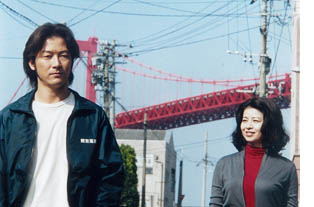 Aoyama manages the crisscrossing relationships delicately, without losing sight of the fact that behind Kenji’s laid-back appearance is a boiling desire to avenge himself on his mother. But she’s his match. A woman of smiling serenity, or smugness, she seems infinitely resilient. The final confrontation of the two, in a prison visiting room, has the giddy sense of one-upmanship of the prison visit in Secret Sunshine. Things turn grim and bleak, yet Sad Vacation manages to feel optimistic without being sentimental; even a flagrantly unrealistic soap bubble at the close seems perfectly in place. I notice that Aoyama has made nearly a film a year since Eureka; why aren’t we (by which I mean, I) seeing them?
Aoyama manages the crisscrossing relationships delicately, without losing sight of the fact that behind Kenji’s laid-back appearance is a boiling desire to avenge himself on his mother. But she’s his match. A woman of smiling serenity, or smugness, she seems infinitely resilient. The final confrontation of the two, in a prison visiting room, has the giddy sense of one-upmanship of the prison visit in Secret Sunshine. Things turn grim and bleak, yet Sad Vacation manages to feel optimistic without being sentimental; even a flagrantly unrealistic soap bubble at the close seems perfectly in place. I notice that Aoyama has made nearly a film a year since Eureka; why aren’t we (by which I mean, I) seeing them?
Some films, like those of Angelopoulos, seem to spit in the face of video. You can’t say you’ve seen them if you haven’t seen them on the big screen. Such was the case with my favorite of the films, The Song of the Birds (El cant dels ocells, 2008) by the Catalan director Albert Serra. It merges an aesthetic out of Straub/ Huillet—black and white, very long static takes, drifts and wisps of action—with a joyous naivete recalling Rossellini’s Little Flowers of St. Francis. Serra’s film also reminded me of Alain Cuny’s L’Annonce fait à Marie (1991) and one of the greatest of biblical films, From the Manger to the Cross (1912). All make modest simplicity their supreme concern.
We three kings of Orient are . . . well, definitely not riding on camels. We are in fact trudging through all kinds of terrain, scrub forests and watery plains and endless desert, to visit the baby Jesus. We are also quarreling about what direction to go, whether to turn back, and why we have to sleep side by side so tightly that our arms go numb. And in an eight-minute take we are struggling up a sand dune, vanishing down the other side, and then staggering up again in the distance.
The three kings aren’t characterized, and they are sometimes unidentifiable in the long-shot framings; only their body contours help pick them out. Intercut with their non-misadventures are glimpses of an angel (whom they may not see) and stretches featuring Joseph and Mary, who caress a lamb. Eventually the infant Himself puts in an appearance, burbling. When the kings finally arrive, one prostrates himself. The image settles into a tidy, unpretentious classical composition and we hear the film’s first burst of music, Pablo Casals’ cello rendering of the folk tune Song of the Birds.
The kings get a chance to bathe in a scummy pool before returning home. Off they trudge. “We’re like slaves!” one complains. In a final shot that would be sheer murk on a DVD, they swap robes and set off in different directions. Did I see them embrace one another? Did they murmur something? I couldn’t tell for sure. Night was falling and they were far away.
Like Casals’ cantata El Pessebre, The Song of the Birds gives us a Catalan nativity. The simplicity is genuine, not faux-naif, and the humility doesn’t preclude humor. Although the shots are quite complex, the spare surface texture invests a familiar story with a plain, shining dignity. Discovering films like this, which you will never see in a theatre and could not bear to watch on video, makes this ambitious festival such a worthy event. It maintains the heritage of one of the world’s great cinema cities.
Next up: A report on films I’m watching at the archive’s vaults on–no kidding–the Rue Gray.
The Metropole, Brussels, 1932.
Thanks to Jean-Paul Dorchain of the Archive for help in finding illustrations. And apologies to readers who came here and found only a stub earlier. An internet gremlin somehow purged the first version of this entry a few hours after it was posted.
B is for Bologna
A big crowd assembles for one of the nightly screenings on the Piazza Maggiore.
Not laziness or old age (we hope) but sheer busyness has reduced our Bologna blogging to a single entry this year. Last year we managed three entries, but this time there was just so much to see, from nine AM to midnight, that we couldn’t drag ourselves away to the laptop. That it was blazing hot and surprisingly humid may have given us less biobloggability as well. Still, DB has many pictures, so maybe a followup blog with unusual images of critics and historians disporting in the sun….
Some backstory: Hosted by the Cineteca of Bologna, Il Cinema Ritrovato is an annual festival of rediscovered and restored films. Every July hundreds of movies are screened in several venues. For our 2007 report, with more background and some orienting pictures, go here and then here and here. Watch a lyrical trailer for the event here.
As before, both KT and DB contribute to this year’s entry. But first, the breaking story.
Freder and Maria, together again for the first time
While we were there, the news of a long version of Metropolis broke. The estimable David Hudson offers a quick guide and an abundance of links at GreenCine. A rumor went around Bologna that fragments of the new Buenos Aires print would be screened, but instead there was a twenty-minute briefing anchored by Martin Koerber of the Deutsche Kinemathek. Along with him, Anke Wilkening (Friedrich-Wilhelm-Murnau Stiftung), Anna Bohn (Universitat der Kunste, Berlin), and Luciano Berriatua (Filmoteca Espanola) provided some key points of information.
*Provenance: The “director’s cut” was released in Argentina during the 1920s, with Spanish intertitles and inserts made at Ufa. A collector acquired a print. (Once more we have a collector to thank for saving film history.) When the Argentine film archive (Museo del Cine Pablo C. Ducros Hicken) received the copy in the 1960s, a 16mm dupe negative was made, and the nitrate original was discarded, a common practice at the time.
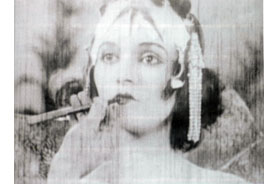 *Condition of the copy: The print is very worn, as the frame reproduced by Die Zeit indicates. Can the torrent of lines and scratches be eliminated? The rescue isn’t likely to be perfect; the damage is perhaps “beyond the reach of our algorithms,” as Martin puts it. To my eye, judging from the Die Zeit frames, many images are lacking in texture and contrast as well.
*Condition of the copy: The print is very worn, as the frame reproduced by Die Zeit indicates. Can the torrent of lines and scratches be eliminated? The rescue isn’t likely to be perfect; the damage is perhaps “beyond the reach of our algorithms,” as Martin puts it. To my eye, judging from the Die Zeit frames, many images are lacking in texture and contrast as well.
*Completeness: Contrary to some reports, virtually all the missing scenes are present on the Argentine print, the single exception being a small portion at a reel end. Among the new sequences are scenes filling in the roles of three characters (Georgy, Slim, and Josaphat), a car journey through the city, and moments of Freder’s delirium.
How can the researchers be confident that the print is so complete? It’s a fascinating story.
Metropolis has been reconstructed many times since the 1960s. In 2001, the Murnau foundation presented a digital restoration of the film supervised by Martin Koerber in collaboration with Enno Patalas. In this version, which is available on DVD (Transit Film, Kino International) about 30 minutes of the original material are missing. In 2003-2005 Enno Patalas and Anna Bohn together with a team at the University of the Arts in Berlin created a “Study Edition” version in which the missing footage was represented by bits of gray leader. For the first time the full length of the film was reconstructed with help from the the original music score.
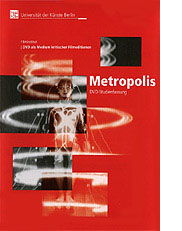 In 2006 a “DVD study edition” was released by the Film Institute of the Berlin University of the Arts (Universität der Künste Berlin; DVD-Studienfassung Metropolis). This scrupulous version includes the original score, a lot of production material, and the complete script by Thea von Harbou. It’s a model of how digital formats can assist documentation of film history. The DVD incorporates production stills and intertitles from the missing scenes, and presents each scene in its original duration (sometimes with only gray leader onscreen). The editors determined the duration of each scene by a critical comparison of the remaining film materials with the music score and other source materials. This DVD edition was released in a limited edition available to educational and research facilities. For information see here or here.
In 2006 a “DVD study edition” was released by the Film Institute of the Berlin University of the Arts (Universität der Künste Berlin; DVD-Studienfassung Metropolis). This scrupulous version includes the original score, a lot of production material, and the complete script by Thea von Harbou. It’s a model of how digital formats can assist documentation of film history. The DVD incorporates production stills and intertitles from the missing scenes, and presents each scene in its original duration (sometimes with only gray leader onscreen). The editors determined the duration of each scene by a critical comparison of the remaining film materials with the music score and other source materials. This DVD edition was released in a limited edition available to educational and research facilities. For information see here or here.
Bohm and Patalas’s comparative method proved itself valid: The Buenos Aires footage fitted the gaps in their study edition perfectly!
A viewing copy will not be forthcoming immediately, given the restoration task, but sooner or later we will have a good approximation of the fullest version of one of the half-dozen most famous silent movies. Getting news like this while among archive professionals is one of the unique pleasures of Cinema Ritrovato. (Special thanks to Dr. Bohn for clarification on several points and to enterprising film historian Casper Tybjerg, who helped me get a copy of the Die Zeit issue.)
Two Davids and a Kevin: Robinson, Brownlow, and Shepard at a critics’ lunch.
Powell meets Bluebeard and Bartók
KT: One of the high points of the week for me was Michael Powell’s 1964 film of Béla Bartók’s short opera Bluebeard’s Castle. It was made for German television and shown in Bologna as Herzog Blaubarts Burg. Unfortunately it was programmed opposite the screening of fragments from Kuleshov’s Gay Canary, but Powell’s post-Peeping Tom films are so difficult to see that I made the difficult choice and gave up hope of seeing the entire Kuleshov retrospective.
Despite being relatively recent in comparison with most of the films shown during the week, Herzog Blaubarts Burg is one of the most obscure. I felt it was an extremely rare privilege to see it, one which I will probably never have again, at least in so splendid a print.
The film belongs to the late period of Powell’s career, after the controversial Peeping Tom had made it impossible for him to work within the mainstream film industry. It was produced by Norman Foster—though not the Norman Foster who directed Journey into Fear and several of the Charlie Chan and Mr. Moto films. This Norman Foster was an opera singer whose stage career was cut short by a dispute with Herbert von Karajan. His widow, Sybille Nabel-Foster, explained this and described how Foster produced and starred in two television adaptations, Herzog Blaubarts Burg and Die lustigen Weiber von Windsor (1966). Foster had originally approached Ingmar Bergman to direct the former, but when that proved impossible, Powell stepped in—and probably a good thing, too. It was definitely his kind of project.
The two performers are perfect for their roles. Foster plays Bluebeard brilliantly, having both a powerful bass voice and the necessary combination of handsomeness and a sense of threat. His co-star, the excellent soprano Ana Raquel Satre, recalls the pale beauties of some of Powell’s earlier films (Kathleen Byron as the increasingly mad Sister Ruth in Black Narcissus, Pamela Brown in I Know Where I’m Going!, and particularly Ludmilla Tcherina in The Tales of Hoffman), but she also bears a resemblance—perhaps deliberately enhanced through costuming and make-up—to Barbara Steele and other horror-film heroines of the 1960s.
The film was shot cheaply in a Salzburg studio, using garish, modernist settings against black backgrounds. These create a labyrinthine, floating space that avoids seeming stage-bound. (Hein Heckroth, the production designer, had previously worked on several Powell films, including The Red Shoes and The Tales of Hoffman.) I was reminded of Hans-Jürgen Syberberg’s Parsifal (1982), which looks somewhat less original in the light of Powell’s film.
As Nabel-Foster explained, after its initial screening on German television, Herzog Blaubarts Burg has been shown seldom because of rights complications with the Bartók estate. Non-commercial screenings have occurred on public television in the U.S. and Australia, but basically the film is off-limits until the copyright expires in 2015, seventy years after the composer’s death. Nabel-Foster has been providently preparing for a DVD release, gathering the original materials.
The print shown was a privately held Technicolor original from the era, in nearly mint condition. (The British Film Institute has a print as well.) The sparse subtitles written by Powell himself were added for this screening.
I’m not convinced that the film is quite the masterpiece that some claim, but it is a major item in Powell’s oeuvre nonetheless, and I felt privileged to have seen it in ideal conditions.
[July 12: Kent Jones, a great admirer of Powell and Bluebeard’s Castle, tells me that he programmed it at the Walter Reade in New York for a centenary retrospective of the director’s work in 2005. Foster’s widow introduced that screening as well.]
Janet Bergstrom and Cecilia Cenciarelli summarize their research on von Sternberg’s lost film The Sea Gull.
1908 and all that
KT: There were several programs of silent shorts, which I could only sample, as they tended to play opposite the Kuleshov films. As usual, the Bologna program included selections of short films from 100 years ago, so we were treated to numerous films from 1908. I was particularly pleased to see The Dog Outwits the Kidnappers, directed by Lewin Fitzhamon, who had made Rescued by Rover two years earlier. That film had been so fabulously successful that it had actually been shot three times as the negatives wore out from the striking of huge numbers of release prints.
The Dog Outwits the Kidnappers at first appears to be a sort of sequel (as it is described in the program), since it stars the same dog (Blair) who had played Rover, and again there is a kidnapped baby. It’s not really a sequel, though, since Cecil Hepworth, who had played the father in the earlier film, here appears as the kidnapper, and the dog is not named Rover. The new film is more fantastical than the original, since the dog races after the car in which the child is abducted and rather than fetching its master, effects the rescue itself by driving the car back home when the villain leaves his victim unattended!
Other 1908 films I particularly enjoyed: In Pathé’s Le crocodile cambrioleur, a thief hides inside a huge fake crocodile and crawls away, creating fear wherever he goes. The Acrobatic Fly by British director Percy Smith, provides a very close-up view of an apparently real fly juggling various small objects. (How was it done? It’s a mystery to me.)
Another retrospective series was “Irresistible forces: Comic Actresses and Suffragettes (1910-1915).” The suffragette films were rather depressing, despite the fact that many were meant at the time to be comic and amusing. Mostly the joke was how masculine these determined women were, a self-verifying proposition when the filmmakers often chose to have the suffragettes played by men. My favorite program was one involving early French female comics. I’ve long been fond of Gaumont’s Rosalie series since seeing a few at an early-cinema conference in Perpignon, France back in 1984. Rosalie, a chubby, cheerful little dynamo played by Sarah Duhamel, was highly entertaining in three films in the “France—Rosalie, Cunégonde et les autres…” program.
As Mariann Lewinsky, who devises these annual series, pointed out, Duhamel is the only early female French comic whose name we know. Léotine, represented here in Rosalie and Léotine vont au théâtre, is played by an anonymous actress. I had not encountered Cunégonde, also anonymous, before, but she proved to be quite amusing as well. I particularly liked Cunégonde femme du monde, where she plays a maid who dresses up as a society lady when her employers go off on a trip; the carefully constructed story and twist ending are impressive for such an apparently minor one-reeler.
It was a treat to see a succession of gorgeous prints of von Sternberg’s films. I particularly enjoyed seeing Thunderbolt (1929) again after many years. Back in 1983 I taught a survey film history course in which I used the director’s first talkie as my example of the transition to sound. Not a good example, I must admit, since Thunderbolt is completely atypical, with its highly imaginative use of offscreen sound. The second half, set primarily in a prison block, involves shouts from unseen cells and a small band that breaks into songs, often completely out of tone with the action, at unexpected moments. Eisenstein and the other Soviet directors would have thoroughly approved of its sound counterpoint. I have to admit that I prefer von Sternberg’s George Bancroft films (Underworld, Docks of New York, and Thunderbolt) to the Dietrich ones. Not only are the plots simpler and more elegant, but they contain a genuine element of emotion that is not, as in the Dietrich series, frequently undercut by irony.
I didn’t make it to many of the CinemaScope films playing on the very big screen in the Cinema Arlecchino theater, but I did enjoy two westerns. Anthony Mann’s Man of the West (1958) and John Sturges’ Bad Day at Black Rock (1954) both looked terrific and were highly popular with everyone we talked to. The latter was particularly a revelation, since in contrast to the Mann, it hasn’t had much of a reputation among cinephiles.
A Rodchenko angle for Yuri Tsivian.
Teacher and experimenter
DB: As Kristin mentioned, we missed a lot of the “Hundred Years Ago” series—a pity, since 1908 is a miraculous year—in order to keep up with one of our favorite directors, Lev Kuleshov.
In the 1960s and 1970s, it was common to say that Eisenstein and Vertov were the most experimental Soviet directors, while the others were more conventional. Then we realized that in films like Arsenal (1928), Dovzhenko had his own wild ways. Then we discovered the Feks team, Kozintsev and Trauberg, and the bold montage of The New Babylon (1929). A closer look at Pudovkin, particularly his early sound films like A Simple Case (1932) and Deserter (1933), revealed that he too was no timid soul when it came to daring cutting and image/ sound juxtapositions. But surely their mentor Kuleshov, admirer of Hollywood continuity and proponent of the simplest sorts of constructive editing, played things safe?
 Wrong again. Just as we must reevaluate the other master Soviet directors (even in their purportedly safe Stalinist projects), so too does Kuleshov deserve a fresh look. He got this thanks to Yuri Tsivian, who with the help of Ekatarina Hohlova (right; granddaughter of Kuleshov and his main actress Aleksandra Hohlova) and Nikolai Izvolov, mounted a superb retrospective. It ranged from Kuleshov’s first solo effort, Engineer Prite’s Project (1918) to his final film, the short feature Young Partisans (1942-3, never released).
Wrong again. Just as we must reevaluate the other master Soviet directors (even in their purportedly safe Stalinist projects), so too does Kuleshov deserve a fresh look. He got this thanks to Yuri Tsivian, who with the help of Ekatarina Hohlova (right; granddaughter of Kuleshov and his main actress Aleksandra Hohlova) and Nikolai Izvolov, mounted a superb retrospective. It ranged from Kuleshov’s first solo effort, Engineer Prite’s Project (1918) to his final film, the short feature Young Partisans (1942-3, never released).
My admiration for Kuleshov, confessed in an earlier blog entry, already led me to spot some weirdnesses in Mr. K’s official classics. The Extraordinary Adventures of Mr. West in the Land of the Bolsheviks (1924) boasts some very un-formulaic cutting in certain passages (including an upside-down shot when cowboy Jeddy ropes the sleigh driver), and By the Law (1926) makes chilling use of discontinuities when the scarecrow Hohlova holds the Irishman at gunpoint. But thanks to the retrospective we can confidently say that Kuleshov was no less venturesome, at least in certain projects, than his pupils.
Soviet specialists already suspected that The Great Consoler (1933) was K’s sound masterpiece, and another viewing confirmed it. It incorporates three registers. William S. Porter, in prison but serving in the pharmacy, witnesses brutality and oppression and is driven to drink. Under the name O. Henry he writes cheerfully sentimental tales as much to console himself as to charm readers. His stories are in turn consumed by shopgirls like Dulcie, a romantic who may not realize how unhappy she is. Kuleshov adds a level of sheer fantasy, represented by a pastiche silent film dramatizing O. Henry’s “A Retrieved Reformation,” in which a safecracker trying to go straight reveals his identity by saving a girl trapped in a bank vault. The embedded story features characters from the other two levels, convict Jimmy Valentine and Dulcie’s lover, a vaguely sadistic businessman in a ten-gallon hat.
The Great Consoler reminds us of the popularity of O. Henry in the Soviet Union, both among readers and the Russian Formalist literary theorists, who were fascinated by his flagrant, playful artifice. (Boris Eikhenbaum’s essay on the writer is one of the most brilliant pieces of literary analysis I know.) Even though Kuleshov must denounce Porter for reconciling the masses to their misery under capitalism, the zest of the embedded film and the unique architecture of the overall project pay tribute to another entertainer who did not forgo experimentation. And Kuleshov’s image of a writer in prison probably had Aesopian significance for artists in the era of Socialist Realism.
K’s other major sound experiment, less widely seen, is Gorizont (1932). The title is at once a man’s name and the Russian word for “horizon”—a metaphor literalized in the final shot of a train leaving a tunnel. As Yuri pointed out, it is one of the few Soviet films centered on a Jew, and so the formulaic growth-to-consciousness plotline takes on a new resonance in the light of Slavic anti-semitism. Lev Gorizont is an amiable, somewhat thick young man who dreams of emigrating to the US to make his fortune. But in New York he finds only poverty and disillusionment, eventually returning home to help make a better society. Famous for its use of sound, Gorizont contains a passage of imaginative “counterpoint.” Both Lev and his friend Smith have been jilted by the social-climber Rosie. As they talk, we hear warm piano music, but not until the end of the scene does Smith speculate that probably Rosie is somewhere listening to Chopin. The music has retrospectively functioned somewhat like crosscutting, suggesting that Rosie now lives among the wealthy.
Kuleshov, like Eisenstein, gained his fame for his ideas on editing and sound montage, but both men were deeply interested in performance. Kuleshov’s idea that the film actor should become an angular mannequin carries on the impulse of Meyerhold’s biomechanics, and he anticipated CGI software in suggesting that human action could be plotted on a three-dimensional grid. Still, Kuleshov usually gives his figures a fluid dynamism that doesn’t seem mechanical. The three narrative registers of The Great Consoler are delineated largely through acting: naturalistic and slowly paced in the prison scenes, rigid and posed in the shopgirl romance, and broad and eccentric in the embedded silent movie.
Kuleshov’s performance theories popped out of other films in the series. What survives of The Gay Canary (1929) centers on a cabaret actress courted by lustful reactionaries during the civil war, and her scenes of fury, as she flings around flowers, vases, and pieces of furniture, come off as acrobatic rather than realistic. Naturally, the circus milieu of 2 Buldy 2 (1929) encourages stunts. A father and son, both clowns, are to perform together for the first time, but the civil war separates them, and the elder Buldy, tempted for a moment to acquiesce to the White forces, casts his lot with the revolution. At the climax Buldy Jr. escapes the Whites thanks to flashy trampoline and trapeze acrobatics; the gaping enemy soldiers forget to shoot. Even Kuleshov’s more naturalistic films show flashes of kinetic, stylized acting. A partisan listens to a boy while draping himself over a door. A Bolshevik official answers the phone by reaching across his chest, twisting his body so the unused arm can hike itself up, right-angled, to the chair.
The interaction of the body with props occurs with a special flair in Young Partisans. A Bolshevik partisan tells some children how a boy saved his life in a German-occupied town (This flashback was directed by Igor Savchenko and functions as a short film on its own.) Having learned their lesson, the kids gather in their schoolroom and under the teacher’s eye draw a map of the partisans’ camp. But when Nazi soldiers burst in, the teacher flips the blackboard over; now all we see is algebra.
A scene of Hitchcockian suspense ensues: Will the Germans turn over the blackboard and discover the map? The tension is enlivened by a grotesque moment, when one alcoholic soldier finds a jar holding a pickled frog and decides to drink the formaldehyde. “Draw a map—show me where the partisans are!” the officer demands. He flips the blackboard, and in a split-second we see a boy crouching behind it; the blackboard swings into place toward us, the map now erased. The boy ducks into his seat, brushing off chalk dust.
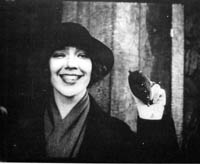 There were plenty of other revelations. We got the reconstructed Prite (was it the first really modern Soviet film?), a bit of an original Kuleshov experiment in constructive editing, and a tantalizing fragment from The Female Journalist (1927), with a surprisingly pensive Hohlova as a modern-day reporter. Sasha (1930), directed by Hohlova herself, was a sympathetic portrait of a pregnant woman. An educational film called Forty Hearts (1930) explained the need to electrify the Soviet countryside and was brightened by faux-naïve animation. Timur and His Crew (1942), with some of the charm of a Nancy Drew movie, showed Young Pioneers helping on the home front; it unexpectedly centered on a girl’s devotion to her military father.
There were plenty of other revelations. We got the reconstructed Prite (was it the first really modern Soviet film?), a bit of an original Kuleshov experiment in constructive editing, and a tantalizing fragment from The Female Journalist (1927), with a surprisingly pensive Hohlova as a modern-day reporter. Sasha (1930), directed by Hohlova herself, was a sympathetic portrait of a pregnant woman. An educational film called Forty Hearts (1930) explained the need to electrify the Soviet countryside and was brightened by faux-naïve animation. Timur and His Crew (1942), with some of the charm of a Nancy Drew movie, showed Young Pioneers helping on the home front; it unexpectedly centered on a girl’s devotion to her military father.
One of the biggest surprises was news of Dokhunda (1936), an ethnographically based fiction set in Tazhikistan. Although the film is lost, Nikolai has reconstructed its plan, revealing that Kuleshov adopted a strange preproduction method. He prepared “living storyboards,” photos of the cast enacting the scenes. He then drew and scratched on them, creating busy, nervous backgrounds or changing the figures’ features and hair styles—Kuleshov as pre-Warhol scribbler, or a graffiti artist tagging his own images.
Nikolai has also finished a DVD edition of Prite that exemplifies what he calls hyperkino, a way of annotating and comparing a film’s images, texts, and supplementary materials for instant access. Another project involves the Yevgenii Bauer classic, The King of Paris (1917), which Kuleshov completed. We haven’t had the intertitles for this, however, but now Nikolai has discovered them, and they will go on the DVD version that is being completed. For more information on these projects and Dokhunda, go to hyperkino.net.
So Kuleshov stands revealed as more supple and ambitious than most of us once thought. Once more Bologna plays to its strengths—filling in gaps but also forcing us to rethink what we thought we knew.
The key issue: What the hell am I going to be seeing now? From left, Olaf Muller, Jonathan Rosenbaum, Don Crafton, Haden Guest, and KT.
So much else to report, so little time. Besides The King of Paris, there was a string of fine 1910s films. Raoul Walsh’s Pillars of Society (1916), while not a patch on his Regeneration of the previous year, offered a solid adaptation of Ibsen. The Dawn of a Tomorrow (1915), James Kirkwood’s Mary Pickford vehicle, seemed to me flat and talky, but others liked it. For me the outstanding item was Paul Garbagni’s In the Spring of Life (1912). Beautifully directed in the tableau style, with precise depth choreography and a stirring scene of a theatre consumed by fire, it starred three men who would become great directors very soon: Sjöström, Stiller, and Georg af Klercker.
Not to mention the von Sternbergs (I liked An American Tragedy much more on this outing), the Scope revivals (Man of the West, Ride Lonesome in a handsome digital restoration from Grover Crisp), my first viewing of Duvivier’s La Bandera (1935), the Monta Bell items (most notably the incessantly energetic Upstage from 1926), and on and on.
What can Gianluca Farinelli, Peter von Bagh, and Guy Borlée, along with their devoted staff members, do for an encore? Bravo! Now take a rest.
Standing Room Only for the rarely seen Children of Divorce (Sternberg/ Lloyd, 1927).












